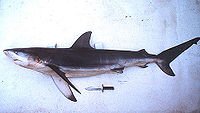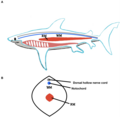Portal:Sharks
Welcome to the shark portal

Sharks range in size from the small
Several species are apex predators, which are organisms that are at the top of their food chain. Select examples include the bull shark, tiger shark, great white shark, mako sharks, thresher sharks, and hammerhead sharks. (Full article...)
Selected article -
Adult dusky sharks have a broad and varied diet, consisting mostly of
Because of its slow reproductive rate, the dusky shark is very vulnerable to human-caused population depletion. This species is highly valued by
Did you know (auto-generated)

- ... that "the Hurricane Shark is real"?
- ... that Alexis Sharkey's last her murder documented her travels to Tulum, Mexico?
- ... that since 2018, IKEA's stuffed toy shark Blåhaj has become a popular Internet meme and an icon of the online transgender community?
- ... that the ampullae of Lorenzini enable sharks to sense electric fields?
- ... that Timo Meier became the first player in San Jose Sharks franchise history to score five goals in one game when he was 25?
- ... that Hixxy and Sharkey created a schism in the UK rave music scene in 1995?
Categories
Related portals
WikiProjects
Selected picture -
More Did you know? -
- ... that no more than 250 mature northern river sharks are estimated to live in the wild?
- ... that the closure of the Tethys Sea 10–14 million years ago led to the sicklefin lemon shark and the lemon shark becoming separate species?
- ... that the spined pygmy shark, dwarf lanternshark and pygmy ribbontail catshark are candidates for being the smallest shark in the world, all maturing at under 20 cm (8 in) long?
- ... that most attacks on humans by the blacktip reef shark consist of people being bitten on their legs or feet while wading in shallow water?
- ... that the egg capsule of the crested bullhead sharkhas paired tendrils extending up to 2 m (6.6 ft), greater than the length of the adult shark?
General images
-
Shark Anatomy (50693674756) (from Shark anatomy)
-
The major features of sharks (from Shark anatomy)
-
Sharksucker (Echeneis naucrates) (from Shark agonistic display)
-
Postural configuration of a Gray Reef Shark as it displays agonistic behaviour, in a sculpture (from Shark agonistic display)
-
Clear agonistic behaviour observed in Great White Shark (from Shark agonistic display)
-
Placoid Scale (from Shark anatomy)
-
A dissected view of the unique four-chambered heart of the sharkChambers: Sinus Venosus, Atrium, Ventricle, Conus Ateriosus (from Shark anatomy)
-
Distribution of highly sensitive ampullae of Lorenzini across the shark's head and rostrum. (from Shark agonistic display)
-
BranchiostomaLanceolatum PioM (from Shark anatomy)
-
A ventral dissection of a pregnant female dogshark exposing its internal gill slits and internal spiracles. (from Shark anatomy)
-
Postural elements of the agonistic display of the Gray Reef Shark (from Shark agonistic display)
-
Dorsal fin diagram with landmarks labeled. (from Shark anatomy)
-
Shark cage diving (from Shark tourism)
-
Sharks swimming outside shark-proof cage with people inside (from Shark cage diving)
-
TheEndangered.(from List of threatened sharks)
Binding legislation and harvest management strategies... are urgently needed to address the disproportionate impact of fisheries on cartilaginous fishes.
–
IUCNglobal study 2010 -
A sign at Pyramid Rock Beach in Hawaii warning about a shark sighting, 2015 (from Shark tourism)
-
Lateral and cross section view of shark's red and white locomotor muscles (from Shark anatomy)
-
Great white shark at Isla Guadalupe, Mexico, August 2006. Animal estimated at 11–12 feet (3.3 to 3.6 m) in length, age unknown. (from Shark tourism)
-
A 14-foot (4.3 m), 1,200-pound (540 kg)Kāne'ohe Bay, Oahu, in 1966
-
Great white shark cages at Isla Guadalupe, Mexico (from Shark cage diving)
-
Depiction of shark anatomy including eggs, pups, and the liver (from Shark anatomy)
-
This grey reef shark demonstrates countershading, with its darker dorsal surface and lighter ventral surface. (from Shark anatomy)
-
Anti-cull protesters on Perth's Cottesloe Beach in Western Australia in 2014 (from Shark culling)
-
The gill slits of a whale shark flaring as it expels water from its pharyngeal cavity. (from Shark anatomy)
-
In a milestone decision in 2013, CITES prohibited international trade in the fins of the scalloped hammerhead (pictured) and four other shark species. (from List of threatened sharks)
Topics
For additional lists of marine life-related
Wikimedia
The following Wikimedia Foundation sister projects provide more on this subject:
-
Commons
Free media repository -
Wikibooks
Free textbooks and manuals -
Wikidata
Free knowledge base -
Wikinews
Free-content news -
Wikiquote
Collection of quotations -
Wikisource
Free-content library -
Wikispecies
Directory of species -
Wikiversity
Free learning tools -
Wiktionary
Dictionary and thesaurus
















































